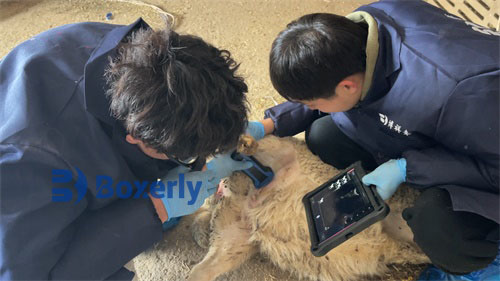Ultrasound assisted diagnosis of anterior gastric relaxation in imported cows. Anterior gastric relaxation is caused by a decrease in excitability of the anterior gastric nerve, weakened contractility, decreased digestive function, prolonged food retention time leading to fermentation and decomposition, production of toxic substances, destruction of the rumen microbiota, digestive dysfunction, and systemic dysfunction. By importing cows and using ultrasound, the rumen condition of cows can be checked to determine.
Sick cows experience mental depression, decreased or absent appetite, grinding teeth, delayed rumination, and reduced heating. The sound of rumen peristalsis weakens or disappears, and the contents of the rumen are soft or sticky, sometimes accompanied by mild rumen distension. The peristaltic sounds of the reticulum and flap stomach weaken or disappear. On imported cattle, it can be observed on ultrasound that the number of rumen peristalsis is relatively low. Defecation of the sick cattle is sluggish, and the feces are hard and dark, in the form of black peat, then diarrhea occurs, and the brown porridge or watery stool is discharged, and the feces have a foul smell. Body temperature, pulse, and respiration generally do not show significant changes, but the pulse increases later on. When there is secondary rumen bloating, breathing becomes difficult; When secondary enteritis occurs, the body temperature rises.
Choose a scientific feeding management system, and adjust daily feed according to the physiological characteristics of cows at different stages of development. Blindly pursuing high yields and unilaterally increasing the content of concentrate in feed are strictly prohibited. The change of feed for each stage should follow the principle of gradual progress, and do not suddenly change the feed composition and feeding schedule. In addition, regardless of the feeding method chosen, the nutritional value of the feed must be guaranteed to be full, supplemented with necessary nutrients such as green hay, vitamins, and minerals, which can effectively prevent the occurrence of symptoms of gastric delay. It is also necessary to frequently use imported cattle and B-ultrasound to check the rumen condition of cattle.
Strengthen the supervision of feed and replace it immediately if mold or decay is found. To properly prepare feed, it is necessary to promptly remove sharp foreign objects from the forage to avoid traumatic diseases caused by accidental ingestion by cows. Imported cows should be regularly checked for their condition using ultrasound. In addition, ensuring sufficient daily exercise for cows and enhancing their physical fitness can effectively prevent pre gastric delay.








